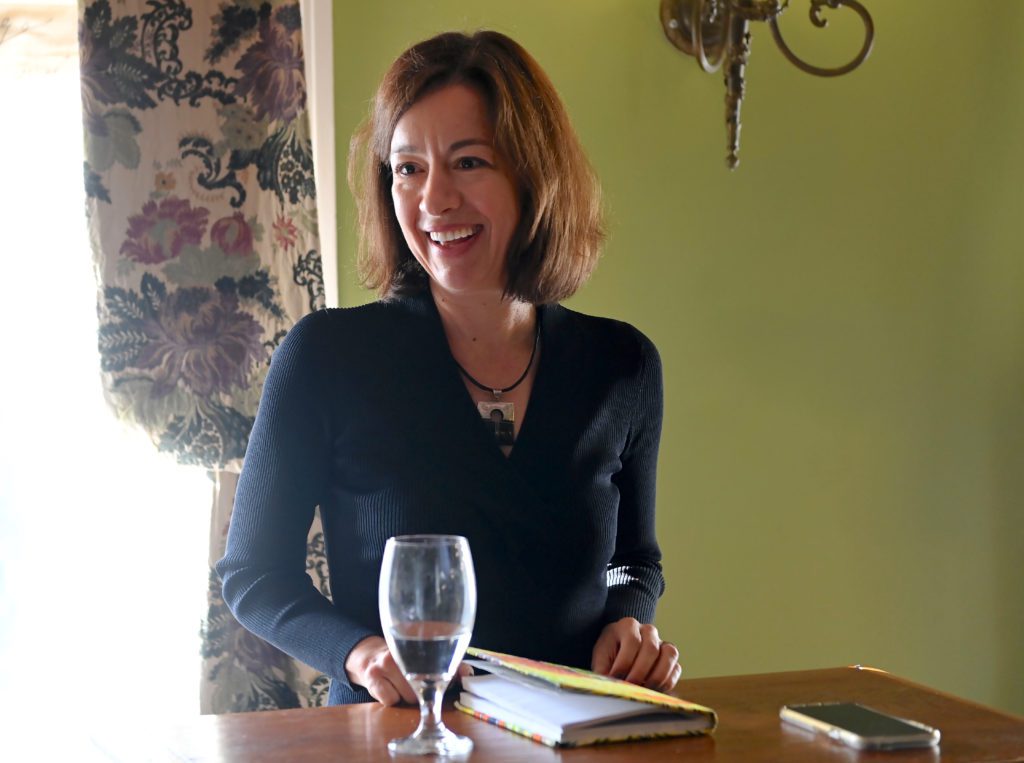Dumbarton Oaks, According to Dr. Batsaki
By • November 21, 2022 0 3798

“What is this place?” pondered Dr. Yota Batsaki when she first encountered Dumbarton Oaks, the Harvard University-owned research institute, museum and garden on 32nd Street in Georgetown. Did anything tie together its Byzantine and pre-Columbian art collections and its specialized library, focusing on those disparate cultures and also on garden design?
Batsaki — who moved from Cambridge, England, in 2011 to become executive director of Dumbarton Oaks, a new position — shared her responses to those questions and others at The Georgetowner’s Nov. 17 Cultural Leadership Breakfast at the Tabard Inn. Her remarks highlighted her efforts to broaden the institute’s mission and strengthen its connections both to Harvard and to the Washington, D.C. community.
A 16-acre estate donated to Harvard in 1940 by Robert and Mildred Bliss, who established the art collections and library, Dumbarton Oaks has a budget funded by the university-managed endowment set up by the Blisses, who had wisely invested in IBM. She called garden admissions, collected from March 15 to Oct. 31, and museum shop sales (admission to the museum is always free) “a drop in the ocean.”
The institute’s director, for a renewable five-year term, is a senior Harvard faculty member, currently pre-Columbian art historian Thomas B. F. Cummins. Though Dumbarton Oaks has a staff of about 100, plus some 50 researchers, according to Batsaki, when she arrived there was “no proper HR,” no dedicated staff in events or communications and no K-12 programming.
Batsaki joked that her Harvard Ph.D. in comparative literature, “makes me perfect in the [executive director] role,” since she isn’t a specialist in Byzantine art, pre-Columbian art or garden design. One of her research interests, however, is the cultural history of plants in the modern period. Besides serving as executive director, she is principal investigator of the Andrew Mellon Foundation-funded Plant Humanities Initiative, which held its capstone conference at Dumbarton Oaks in September.
This year, Dumbarton Oaks is celebrating the centennial of its famed garden, designed by Beatrix Farrand in collaboration with Mildred Bliss. Batsaki referred to several garden-related initiatives: contemporary art installations, possibly leading to an artist residency program; plans for a new greenhouse education building by Selldorf Architects and Reed Hilderbrand Landscape Architects; fighting boxwood blight and other horticultural threats; and cooperation with science-oriented plant collections such as Harvard’s Arnold Arboretum in Boston.
The key to the Harvard relationship is the humanities, about which there is a “sense of doom and gloom,” Batsaki noted, citing the decline in undergraduate enrollment in humanities majors. Dumbarton Oaks now hosts 12 interns and 12 fellows per year from Harvard, offering “pathways into careers.”
As for organizations here in D.C., Batsaki mentioned developing partnerships with the National Gallery of Art, George Washington University and the Kreeger Museum, which occupies a building designed in 1963 by Philip Johnson, who designed the Pre-Columbian Gallery at Dumbarton Oaks the same year.
One of Batsaki’s themes was the challenge of communicating the “mosaic” that is Dumbarton Oaks, a campus part private and part public, to “these different constituencies that also don’t overlap.” Visitors to the garden may never visit the museum, for instance.
Another example: people who enjoy modern music may only know the name Dumbarton Oaks because of Igor Stravinsky’s Dumbarton Oaks concerto; those interested in political history may only know it because of the Dumbarton Oaks Conversations (which led to the United Nations Charter). Remarkably, the concerto’s 1938 private premiere and the 1944 conversations took place in the very same room, the elegantly furnished Music Room, where a highly regarded but low-profile Renaissance and medieval concert series has been presented for over 80 years.
These are just two of the constituencies ripe for nurturing: the music lovers through new commissions for composers and the history buffs through expanded interpretation, including outreach to Model United Nations programs. On the topic of diplomacy (Robert Bliss, a foreign service officer in Paris during World War I, later served as ambassador to Argentina), “Covid set Dumbarton Oaks several years back connecting with embassies,” Batsaki said.
Cases of confusing Dumbarton Oaks, Dumbarton House, Dumbarton Street and other Georgetown Dumbartons came up during the Q&A. Mark Hudson, executive director of neighboring Tudor Place, said (tongue in cheek) that when visitors ask if Tudor Place is Dumbarton Oaks he says “yes” and invites them in.
Another audience member, Neville Waters, who recalled being escorted off the grounds as a boy, asked Batsaki if she would lift the presumably lifetime ban. She inquired if he had jumped in the garden pool, a former “rite of passage” for Georgetown University students.

Cynthia McKee of Balfour Palisades, Yota Batsaki, executive director of Dumbarton Oaks, and Samira Farmer of Doyle. Georgetowner photo.

